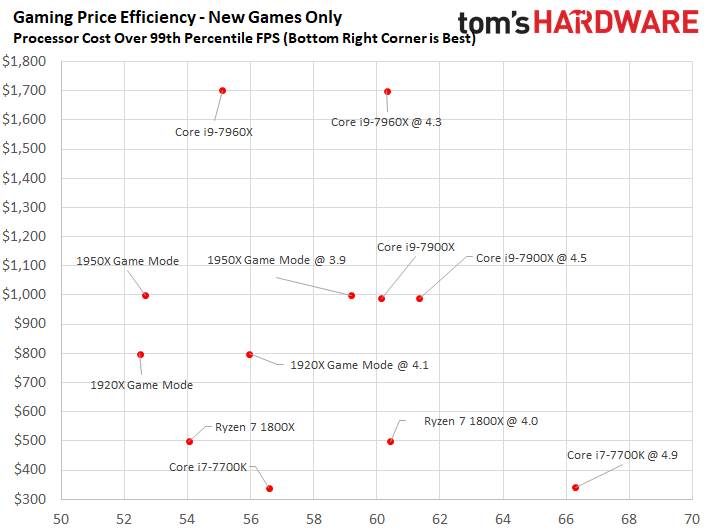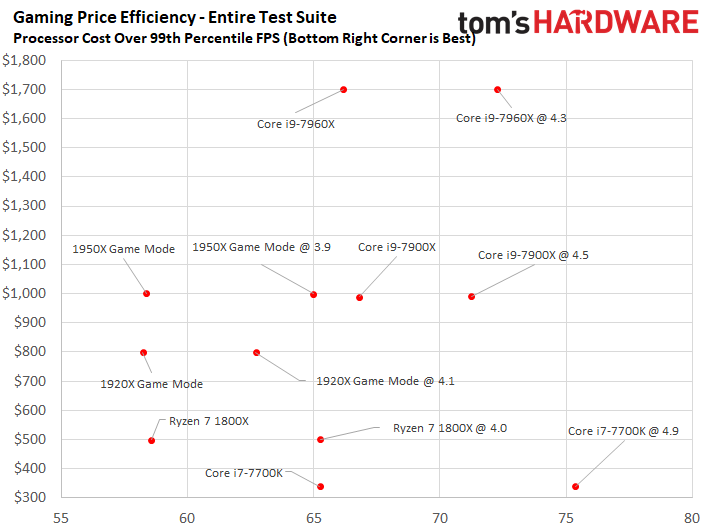Intel Core i9-7960X Review: Skylake-X At 16 Cores
Why you can trust Tom's Hardware
Conclusion
Intel unabashedly aims its high-end desktop CPUs at those seeking the ultimate in performance, and from our first round of testing, it's apparent that Core i9-7960X delivers this across a range of heavily threaded workloads like rendering, encoding, and file compression. Aggressive Turbo Boost binning, which is far more ambitious than anything Broadwell-E offered, yields impressive results in lightly-threaded workloads too. Though there are rare exceptions, -7960X is also exceptional in games. It's no longer necessary to compromise alacrity in one discipline for devastating speed in another. The top Skylake-X CPUs simply crank up the clocks when their many cores aren't needed.
Of course, you have to pay a premium for this privilege. And if you aren't explicitly running well-threaded tasks on a regular basis, there's not much reason to spend a small fortune on Skylake-X. For gaming, we're using a geometric mean of the 99th percentile frame times, which we convert into an FPS measurement, to provide an easy-to-read performance outlook. The 99th percentile results are a good indicator of smoothness. Ryzen's extra cores could enable more performance in the future as software evolves to utilize them better, so we also include a chart with newer games that exploit host processing resources more thoroughly.


Enthusiasts who mostly plan on gaming: mainstream chips are still the smart choice.
It is remarkable that, for years, developers wrote code capable of utilizing a handful of cores, at most. Yet, in the span of a few months, we suddenly have processors with so many cores that some applications won’t even load. It’s easy to imagine that we’ll start seeing more software optimized for multi-core architectures in the years to come. AMD gets a lot of credit for this; the company's new processors obviously spurred Intel to respond with lower prices and faster processors.
But Intel still charges a big premium for access to its 16-core -7960X. You'll pay $700 more than Ryzen Threadripper 1950X or the 10-core Core i9-7900X. For many, an undeniable performance advantage might not be worth that extra money. But if every second you save translates to dollars, the higher price tag might be worth paying.
Although Intel isn't charging as much per core this generation, the company's segmentation practices persist. AMD gives you ECC memory support and more PCIe connectivity, for example. Meanwhile, Intel disables ECC support to dissuade its Xeon customers from adopting a less expensive platform, and it slowly shaves off PCIe lanes as you descend the Core hierarchy.
Grueling time constraints limited what we could do with Core i9-7960X on this first outing with the chip. But we do have more tests to run, and you can bet we'll revisit the exhaustive thermal/power analysis that went into our Core i9-7900X review. Plus, Core i9-7980XE is sitting here, waiting for a fixed motherboard firmware to truly unlock its potential; test results from Intel's flagship will follow shortly.
Get Tom's Hardware's best news and in-depth reviews, straight to your inbox.
In the meantime, there's no question that Core i9-7960X is the fastest 16-core processor available. Intel is simply charging too much for the pleasure of owning one.
MORE: Best CPUs
MORE: Intel & AMD Processor Hierarchy
MORE: All CPUs Content

Paul Alcorn is the Editor-in-Chief for Tom's Hardware US. He also writes news and reviews on CPUs, storage, and enterprise hardware.
-
David_693 I think there is something missing here: 'Similar to the other Skylake-X CPUs, the -7960X supports up to DDR4-2666 memory.'Reply -
David_693 Well, for now, my i7-7700k is no slouch, can't wait to see what the i7-8700K's will be able to do. No rush to upgrade yet as I've only had the 7700k since March. Thanks to AMD for pushing Intel to produce better options.Reply -
klipschkiller Really, Intel, is this a joke? Why release a chip that requires water cooling, have bad thermals and power consumption to previous AMD's bulldozer.Reply -
hannibal Well, it is good for competition that AMD have cooler and better behaving product this time compared to Intel. It forces Intel to do better next time!Reply
Go AMD go! And keep Intel in its toes! Better products, better prices (?) to the customers. I hope that Intel is forced to reduce the pricing... -
zippyzion That is a supremely powerful chip... but, man... at what cost? I give a nod to the speed and power, but it is anything but practical. It isn't even that much faster than the competition in most tests, and a good deal of that competition comes from Intel themselves. It is really a case of, "why bother?". I'd suggest just getting the 7900 or the 1950 if you are looking at this segment. Why spend so much more for so little extra?Reply -
phobicsq Intel needs to stop using paste and do it right. It's beyond comprehension that they charge a lot more and and yet AMD charges less and does it right.Reply